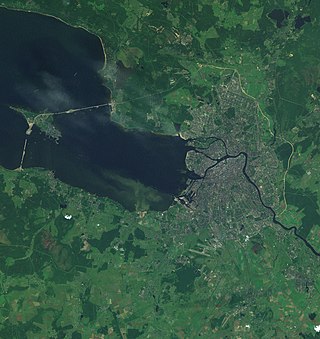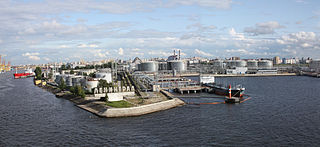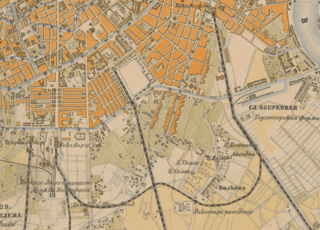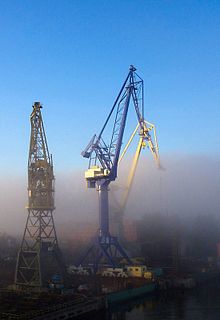
The Gulf of Finland is the easternmost arm of the Baltic Sea. It extends between Finland to the north and Estonia to the south, to Saint Petersburg in Russia to the east, where the river Neva drains into it. Other major cities around the gulf include Helsinki and Tallinn. The eastern parts of the Gulf of Finland belong to Russia, and some of Russia's most important oil harbors are located farthest in, near Saint Petersburg. As the seaway to Saint Petersburg, the Gulf of Finland has been and continues to be of considerable strategic importance to Russia. Some of the environmental problems affecting the Baltic Sea are at their most pronounced in the shallow gulf. Proposals for a tunnel through the gulf have been made.

Pulkovo Federal State Unified Aviation Service Company was an airline with its head office in Moskovsky District, Saint Petersburg, Russia. It operated the Pulkovo Airport and was 100% state owned. It was the third largest airline in Russia. On 29 October 2006 it completed a merger with government owned Federal State Unified Aviation Service Company to form a new company under the Rossiya name.

Leningrad Oblast is a federal subject of Russia. The oblast has an area of 84,500 square kilometres (32,600 sq mi) and a population of 2,000,997 ; up from 1,716,868 recorded in the 2010 Census. Leningrad Oblast is highly industrialized. Its administrative center and largest city is Gatchina.

Pulkovo Airport is an international airport serving St. Petersburg, Russia. It consists of one terminal which is located 23 km (14 mi) south of the city centre. The airport serves as a hub for Rossiya Airlines and as focus city for Smartavia. It is responsible for serving the citizens of Saint Petersburg and the Leningrad Oblast: a total of 6,120,000 people. It is the 29th-busiest airport in Europe in 2022.

Kotlin is a Russian island, located near the head of the Gulf of Finland, 32 kilometres (20 mi) west of Saint Petersburg in the Baltic Sea. Kotlin separates the Neva Bay from the rest of the gulf. The fortified city of Kronstadt is located on the island and forms part of a World Heritage Site that is Saint Petersburg and Related Groups of Monuments. The island serves as a gateway to Saint Petersburg and as such has been the site of several military engagements.

The Saint Petersburg Flood Prevention Facility Complex, unofficially the Saint Petersburg Dam, is a 25 km (16 mi) long complex of dams for flood control near Saint Petersburg, Russia. The dam extends from Lomonosov northward to Kotlin Island, then turns east toward Cape Lisiy Nos near Sestroretsk.

Pskovavia was a passenger and cargo airline based in Pskov, Russia. It operated international and domestic charter passenger and cargo services as well as regular scheduled flights between Pskov and Moscow. Its main base was Pskov Airport.

The Historic Centre of Saint Petersburg and Related Groups of Monuments is the name used by UNESCO when it collectively designated the historic core of the Russian city of St. Petersburg, as well as buildings and ensembles located in the immediate vicinity as a World Heritage Site in 1991.

The Saint Petersburg Ring Road is a 142 km orbital freeway encircling Saint Petersburg, Russia. The city's only beltway, it is listed in the Russian road numbering system as federal public highway A-118.

The Riihimäki–Saint Petersburg railway is a 385-kilometre (239 mi) long segment of the Helsinki–Saint Petersburg connection, which is divided between Saint Petersburg and Leningrad Oblast in Russia and the province of Southern Finland in Finland.

Saint Petersburg is a city and a federal subject located in the Northwestern Federal District of Russia. It stands at the mouth of the Neva River at the east end of the Gulf of Finland.

Oktyabrskaya Railway or October Railway is the subsidiary of RZD, servicing railway lines in the north-west of Russia. It stretches from Moscow's Leningrad Terminal in the south to Murmansk beyond the Arctic Circle in the north. The total length of the lines is over 10,000 km. The headquarters are located in Saint Petersburg.

The Great Port of St. Petersburg or Port of St. Petersburg is a major seaport serving the city of St. Petersburg in northwest Russia. The port's water area is 164.6 km2. The mooring line is 31 km long and the water is 25 metres (82 ft) deep at the port's deepest anchorages. Since 2011, the port has been under the authority of a state-owned enterprise, the Port Authority of the Great Port of St. Petersburg. This agency oversees commercial navigation in the seaport of St. Petersburg and beyond in the designated areas of responsibility of the Russian Federation.

Saint Petersburg, formerly known as Petrograd (1914–1924) and later Leningrad, is the second-largest city in Russia after Moscow. It is situated on the River Neva, at the head of the Gulf of Finland on the Baltic Sea. The city had a population of roughly 5.6 million residents as of 2021, with more than 6.4 million people living in the metropolitan area. Saint Petersburg is the fourth-most populous city in Europe, the most populous city on the Baltic Sea, and the world's northernmost city of more than 1 million residents. As Russia's Imperial capital, and a historically strategic port, it is governed as a federal city.

Saint Petersburg – second-largest city in Russia. An important Russian port on the Baltic Sea, it has the status of a federal subject. Its name was changed to "Petrograd" in 1914, then to "Leningrad" in 1924, and back to Saint Petersburg in 1991.

Global Ports stands as the foremost operator of container terminals in the Russian market boasting impressive throughput capacity and container turnover. Global Ports’ terminals are located in the Baltic and Far Eastern basins. These areas serve as pivotal hubs for foreign trade cargo flows within the Russian Federation.

The Connecting Line is a historical railway line in the southern part of Saint Petersburg, Russia, that may be considered the initial step in the process of forming a unified Russian railway network. It was constructed in 1853 and started operation in 1854. Before that, Russian railways consisted only of several separate lines connecting a few major cities. Decades later, in the first half of the 20th century, the line was merged with the later-built neighboring Putilovskaya Line, also known as the Port Line, and was lengthened to the city's northern territories forming the so-called Northern Semi-Ring and the consequent massive Saint Petersburg railway hub.



















